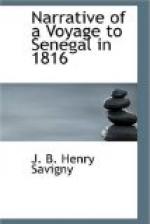The long-boat was the last which we lost sight of. It descried the land and the Isles of Arguin, the same evening before sun-set: the other boats must, therefore, necessarily, have seen it some time before, which proves, we think, that when we were abandoned, we were at a very small distance from the coast. Two boats succeeded in reaching Senegal without accident; they were those in; which were the governor and the commander of the frigate. During the bad weather, which forced the other boats to make the land, these two had a great deal of difficulty to resist a heavy sea and an extremely high wind. Two young seamen gave proofs of courage and coolness in these critical moments, in the barge. Mr. Barbotin, eleve of the marine: and in the captain’s barge, Mr. Rang,[32] also an eleve of the marine, as deserving of praise for his knowledge, as for the courage he displayed on this occasion; both of them, as long as the bad weather lasted, remained at the helm, and guided the boats. One Thomas, steersman, and one Lange, the boatswain’s mate, also shewed great courage, and all the experience of old seamen. These two boats, reached the Echo corvette, on the 9th, at 10 o’clock in the evening, which had been at anchor for some days, in the road of St. Louis. A council was held, and the most prompt and certain measures adopted to assist those who were left on board the boats and the raft.
The Argus brig was appointed for this mission. The commander of this vessel, burning with eagerness to fly to the assistance of his unfortunate countrymen, wanted to set sail that very moment; but causes, respecting which we shall be silent, fettered his zeal; however, this distinguished officer executed the orders which he received with uncommon activity.
Let us return to the history of the four other boats; and first, that of the principal, which was the long-boat. As soon as it descried the land, it tacked and stood out in the open sea; because it was on the shallows, and it would have been imprudent to pass the night in one metre, or one metre 30 centimetres of water; it had already grounded two or three times. On the 6th, about four o’clock in the morning, finding itself too far from the coast, and the sea very hollow, it tacked, and in a few hours saw the coast for the second time. At eight o’clock, they were extremely near, and the men ardently desiring to get on shore, sixty-three of the most resolute were landed; arms were given them, and as much biscuit as could be spared; they set out in search of Senegal, following the sea-coast. This landing was effected to the North of Cape Meric, eighty or ninety leagues from the Isle of St. Louis.[B7] This vessel then stood out to sea. We will leave, for the present, these sixty-three poor people who have been landed on the sands of Cape Meric; and shall return to them in the sequel.




